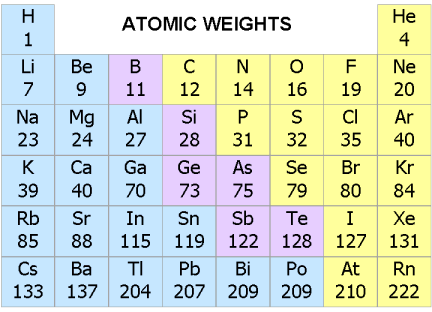
MAIN GROUP ELEMENTS

Select the best single answer for each question:
1. Evaluate 1.2253 ´ 71.4 to the correct number of significant figures.
| A) | 87 | |
| B) | 87.5 | |
| C) | 87.49 | |
| D) | 87.486 | |
| E) | 87.4864 | |
2. Evaluate 19.10 mL + 1.52 L to the correct number of significant figures.
| A) | 1.54 ´ 103 mL | |
| B) | 1.5 ´ 103 mL | |
| C) | 1539 mL | |
| D) | 1539.1 mL | |
| E) | 1539.10 mL | |
3. Which is the largest mass?
| A) | 100 g | |
| B) | 100 ng | |
| C) | 100 kg | |
| D) | 100 mg | |
| E) | 100 mg | |
4. How many cubic meters are there in 100 cubic millimeters?
| A) | 108 | |
| B) | 1011 | |
| C) | 10-6 | |
| D) | 10-8 | |
| E) | 10-7 | |
5. Give the ratio neutrons/protons in
![]()
| A) | 1.13 | |
| B) | 1.54 | |
| C) | 2.16 | |
| D) | 1.20 | |
| E) | 1.00 | |
6. Give the number of electrons in the ion
![]()
| A) | 56 | |
| B) | 28 | |
| C) | 71 | |
| D) | 39 | |
| E) | 123 | |
7. The formula for potassium bromide is
| A) | KBr | |
| B) | K2Br3 | |
| C) | KBr2 | |
| D) | K2Br | |
| E) | K3Br2 | |
8. The charge on the metal ion in the ionic compound FeO is
| A) | +1 | |
| B) | +2 | |
| C) | -1 | |
| D) | -2 | |
| E) | +3 | |
9. The formula for calcium phosphate is
| A) | CaPO4 | |
| B) | Ca2(PO4)3 | |
| C) | Ca3(PO4)2 | |
| D) | Ca3P2O8 | |
| E) | Ca3P3O12 | |
10. The total number of sodium ions in 2 moles of sodium carbonate is:
| A) | 3.58 ´ 1024 | |
| B) | 1.30 ´ 1024 | |
| C) | 1.64 ´ 1024 | |
| D) | 6.02 ´ 1023 | |
| E) | 2.41 ´ 1024 | |
11. In the mineral carnotite K2(UO2)3(VO4)2·3H2O what is the ratio of
![]()
| A) | 1.50 | |
| B) | 2.67 | |
| C) | 1.33 | |
| D) | 3.25 | |
| E) | 2.83 | |
12. The formula for the compound iron(III) chloride hexahydrate is
| A) | FeCl3·6H2O | |
| B) | Fe3Cl·6H2O | |
| C) | FeCl3·7H2O | |
| D) | Fe3Cl·7H2O | |
| E) | Fe3Cl(H2O)6 | |
13. The molecular weight of nitric acid is
| A) | 51 | |
| B) | 63 | |
| C) | 47 | |
| D) | 79 | |
| E) | 35 | |
14. What volume of 1.25 M sulfuric acid must be added to water to preparet 2.00 L of a 0.440 M solution?
| A) | 478 mL | |
| B) | 532 mL | |
| C) | 650 mL | |
| D) | 704 mL | |
| E) | 886 mL | |
15. The systematic name of the compound PCl5 is
| A) | phosphorus(V) chloride | |
| B) | phosphorus trichloride | |
| C) | phosphorus pentachloride | |
| D) | phosphorus(V) trichloride | |
| E) | phosphorus(V) pentachloride | |
16.
Two successive reactions A ®
B and B ®
C have yields of 36% and 72%, respectively.
The overall yield for conversion of A into C is:
| A) | 43% | |
| B) | 26% | |
| C) | 38% | |
| D) | 52% | |
| E) | 100% | |
17. What mass of A (MW =74.60) yields 75.0 g of C (MW = 48.32) by the reaction
3 A ® 2 B + 5 C
| A) | 75.0 g | |
| B) | 86.3 g | |
| C) | 94.6 g | |
| D) | 52.1 g | |
| E) | 69.5 g | |
18. What volume (mL) of a 0.125 M solution of K2Cr2O7 (MW = 294.21) contains 1.85 g of K2Cr2O7?
| A) | 50.3 mL | |
| B) | 104 mL | |
| C) | 42.2 mL | |
| D) | 81.5 mL | |
| E) | 75.0 mL | |
19. Find the empirical formula of a compound that contains 0.912 g of phosphorous and 0.706 g of oxygen in a 1.618 g sample.
| A) | P3O2 | |
| B) | P3O4 | |
| C) | P2O3 | |
| D) | P2O5 | |
| E) | PO2 | |
20. What mass of CO2 is produced when 6.0 g of C2H2 and 10.0 g of O2 react by
2 C2H2 + 5 O2 ® 4 CO2 + 2 H2O
| A) | 12.4 g | |||
| B) | 21.5 g | |||
| C) | 13.2 g | |||
| D) | 11.0 g | |||
| E) | 9.6 g | |||
![]()